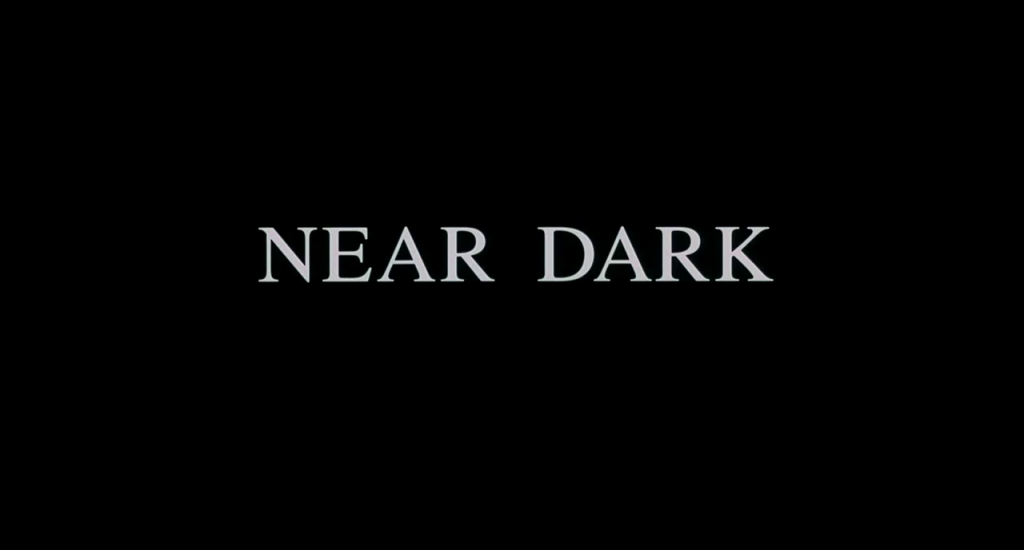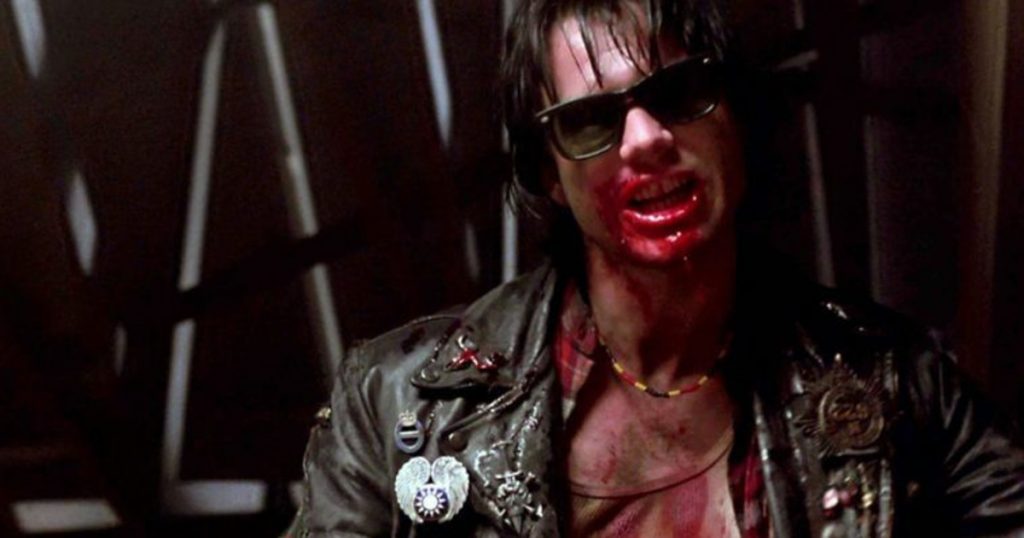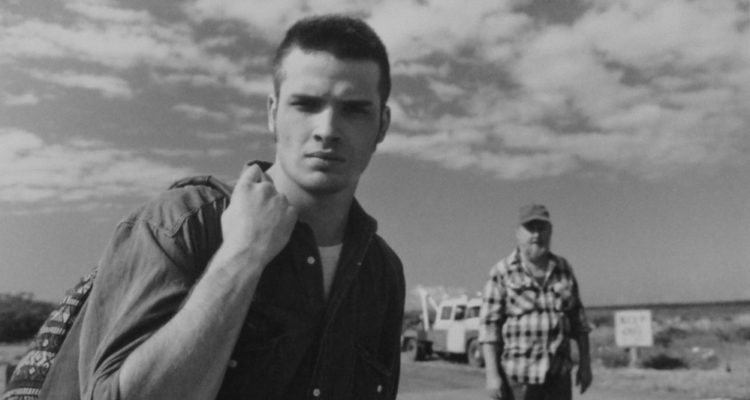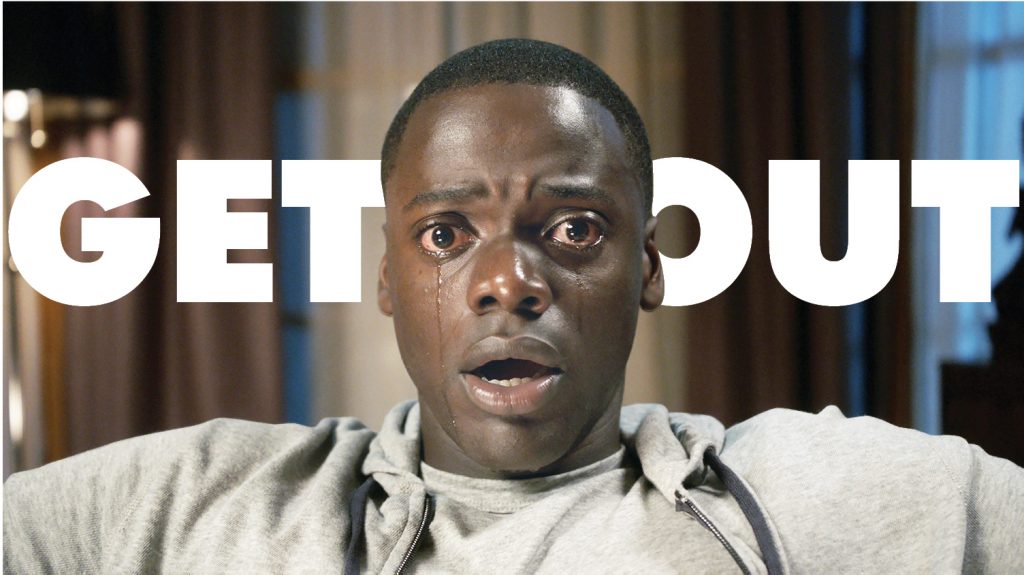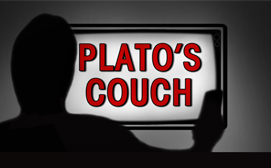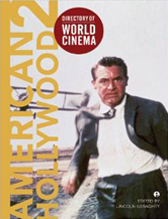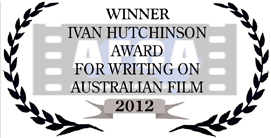
Plato’s Couch – NEAR DARK references
The following resources are cited in the Plato’s Couch podcast episode on Near Dark (Listen HERE):
Benson-Allott, Caetlin (2010). Undoing Violence: Politics, Genre, and Duration in Kathryn Bigelow’s Cinema, Film Quarterly, 64(2), pp. 33-43
Bigelow, Kathryn (Director). (1987). Near Dark, USA: F/M Entertainment
Braudy, Leo (2010), Near Dark: An Appreciation , Film Quarterly, 64(2), pp. 29-32
Coburn, Marcia (1987). Revamping Vampires, Chicago Tribune, October 11th 1987
Gregory, David (director). (2002), Living in Darkness, USA: Blue Underground
Keough, Peter (ed). (2013). Kathryn Bigelow Interviews, The University Press of Mississippi, Jackson
Lane, Christina (1998). From The Loveless to Point Break: Kathryn Bigelow’s Trajectory in Action, Cinema Journal, 37(4), pp.59-81
Powell, Anna (1994). Blood on the Borders: Near Dark and Blue Steel, Screen, 35(2), pp.136-156
Scott, Jay (1987). Vampire myth spawns new terrors in seductive demons of Near Dark, The Globe and Mail, October 2nd 1987
Sharrett, Christopher (1993). The Horror Film in Neoconservative Culture, Journal of Popular Film & Television, 21(3), pp.100-110
Smith, Gavin (1995). Momentum and Design: Kathryn Bigelow interviewed by Gavin Smith, Film Comment, 31(5), pp.46-60
Plato’s Couch intro/outro music: Vitus Von Degen – The Firenze Incident
Plato’s Couch – NEAR DARK (1987)
Kathryn Bigelow’s Near Dark (1987) is the subject of the first episode of Plato’s Couch. Here I explore issues of genre, gender, violence and the film’s production history.
Podcast (platoscouch): Play in new window | Download
PODCAST: Plato’s Cave – September 25th
In this week’s episode the team discuss Kingsman: The Golden Circle, Nocturama and It’s Only the End of the World. With Thomas Caldwell, Alexandra Heller-Nicholas and Josh Nelson.
Plato’s Cave – September 25th (Podcast link)
PODCAST: Plato’s Cave – September 18th
In this week’s episode the team discuss mother!, I Am Not Your Negro and Patti Cake$. With Thomas Caldwell, Alexandra Heller-Nicholas, Emma Westwood and Josh Nelson.
Plato’s Cave – September 18th (Podcast link)
ANALYSIS: Broken Highway
REVIEW: David Lynch: The Art Life
“I had this idea that you drink coffee, you smoke cigarettes and you paint, and that’s it. Maybe girls come into it a little bit. But basically it’s the incredible happiness of working and living that life”
– David Lynch on The Art Life
David Lynch recently caused a stir when, in an interview with the Sydney Morning Herald, he confirmed that Inland Empire (2006) would be his final feature film. Such claims should almost certainly be taken with the caveat “for now”. This is, after all, the same director who announced back in early 2015 that he was walking away from the highly anticipated Twin Peaks revival and that the show would in all likelihood proceed without him. Helmed by Lynch, the third season of Twin Peaks releases on Showtime in a matter of days. When it comes to David Lynch, things are rarely as they appear on the surface.
The same could be said for Lynch’s filmmaking career. A cursory glance across his filmography reveals a body of work that is far more diverse than the prominent psychosexual noir stylings – all too easily summed up as “Lynchian” – might have you perceive. DUNE (1984), Twin Peaks: Fire Walk with Me (1992), The Straight Story (1999) and even Inland Empire confirm Lynch as a director unafraid to defy the neat and occasionally narrow expectations of his audience. In art, as in person, Lynch rejects conventionality. Given that, it should be unsurprising that despite his reputation for reclusiveness (and reluctance to discuss his work) that David Lynch: The Art Life offers an uncharacteristically intimate and open portrait of the man, his upbringing and his art.
From the opening shot in which Lynch appears seated in profile, cigarette in hand, his view fixed out of frame, the documentary’s mood is one of softly spoken contemplation and reflection. Narrating stories of his childhood, from the idyllic Idaho to the darker recesses of Virginia and later Philadelphia, one immediately gets the sense of a man caught between contrasting worlds, a recurring theme across his various art forms. This deliberate association of personal memory with Lynch’s work is further reinforced through the drawings, paintings, photography, archival imagery and grainy home movies that accompany his narration. In one such recollection, retold with a trademark dream-like charm Lynch describes the first time he witnessed a naked woman. Though paired with abstracted photographs of the female form, the description simultaneously conjures memories of the scene where Dorothy Vallens (Isabella Rossellini) emerges naked and battered on Jeffrey’s front lawn in Blue Velvet (1986).
The strategy of framing Lynch’s artwork as representations of his personal experiences is key to this documentary and it serves to reinforce the director’s auteurist credentials even as it sidelines his film work, focusing instead on his art life prior to Eraserhead (1977). It is in Lynch’s childhood and early years as an artist that director Jon Nguyen (and co-directors Rick Barnes and Olivia Neergaard-Holm) attempt to locate the origins for the recurring themes and visual motifs – e.g. the interplay between surfaces and dark interiors, the fascination with industrial forms and the recurring female figures – that inhabit Lynch’s oeuvre. But more significantly, the approach here redresses a common misperception regarding Lynch’s art: that his painting, sculpture and photographic work are somehow secondary in value to his filmmaking endeavours. If anything, David Lynch: The Art Life convincingly situates Lynch’s cinema as an extension of the artistic practices he’d developed long before Eraserhead, as his earlier short films Six Men Getting Sick (Six Times) (1967), The Alphabet (1968), and The Grandmother (1970) ably attest.
Given the way earlier documentaries have tended to downplay Lynch’s non-cinematic art, and adopted more common ‘making of’ style approaches with cast/crew interviews – e.g. David Lynch: Pretty as a Picture (1996) and David Lynch: One (2006) – The Art Life offers a far more personal and studious depiction of the director as artist. Stylistically, the film also comes closest to reproducing the signature moodiness of Lynch’s cinema through the play of images that fade to black, degraded film stock and the steady, occasionally discordant soundtrack that underscores the film’s catalogue of visuals. But beyond the formal sensibility the strength of the documentary lies in the way it manages to be both an endearing study of the artist but not at the expense of Lynch’s trademark enigmatic persona. Like he has for much of his career, Lynch teases us with insights and revelations but in the end, particularly when it comes to the artwork, much is left up to the audience to decipher.
Should Lynch remain true to his vow never to return to filmmaking, one thing that The Art Life makes abundantly clear, is that alone in his art studio or spending time with his young daughter Lulu, the one-time feature director will be perfectly at home with that decision.
ANALYSIS: Get Out
In this piece written for Overland, Alexandra Heller-Nicholas and I examine issues of racial politics, cinematic representation and their relationship to the horror genre in writer-director Jordan Peele’s debut feature Get Out.
Get Out and the Horror of Representation (link to article)
Viet Kong: Aping America’s Heart of Darkness
“The word remake is anachronistic to the degree to which our awareness of the preexistence of other versions (previous films of the novel as well as the novel itself) is now a constitutive and essential part of the film’s structure: we are now, in other words, in “intertextuality” as a deliberate, built-in feature of the aesthetic effect and as the operator of a new connotation of “pastness” and pseudohistorical depth, in which the history of aesthetic styles displaces “real” history.”
– Frederic Jameson in Postmodernism, or the Cultural Logic of Late Capitalism
Compared to Kong: Skull Island, the latest cinematic outing for the ‘Eighth Wonder of the World’, the original King Kong (1933) might appear to some contemporary audiences like a relic from a lost civilisation. The stop-motion animation and detailed small scale sets that at one time seemed the height of cinematic innovation have now been all but superseded by the intangible CGI creations of the modern-day blockbuster. And yet, in spite of these pronounced technological changes and the numerous remakes (or reincarnations) that span these two films, the ideological landscape occupied by the iconic ape continues to provide a rich terrain for exploration.
Until now the critical response to Hollywood’s King Kong films has tended to focus on two key discursive areas: race and sexuality. Recounting the plot of the 1933 film, in which a creature worshipped by a tribal community is removed from his jungle home, placed in chains and brought to the USA as entertainment for a white audience requires little in the way of sub-textual analysis. In addition to reproducing a narrative of African slavery, the film overtly trades on (whether consciously or otherwise) a common racist association of African Americans as sub-human or ape-like. Moreover, in an era where segregation still reigned over much of the USA, it’s not surprising that when Kong inevitably breaks free from his shackles and threatens the white civilisation into which he has been thrust, that he is ultimately destroyed by violent force. But throughout the various versions of King Kong, this ideological depiction of race is inextricably linked to the film’s treatment of sexuality. As David N. Rosen (1975) points out in respect of the 1933 version:
In this case we have a giant ape (literally a huge, hairy monster) and his unrestrained, headlong pursuit of a “blonde,” that archetypical Hollywood sex object, ending on top of the world’s foremost phallic symbol. The sexual theme touches on the standard racist myth of the black male’s exaggerated sexual potency, and the complementary notion of his insatiable desire for white women.1
While Kong’s desire for his female counterpart remains one-sided in the original film – Fay Wray’s character shows little affection or empathy towards her monstrous captor which feeds into the film’s threatening sexual undertones – in the later versions, including those featuring Jessica Lange (1976) and Naomi Watts (2005) the central relationship is recast in more mutual terms. Irrespective of the extent to which these bestial desires are reciprocated however, the racial and sexual themes established in King Kong’s first appearance provided a foundation that subsequent filmmakers have returned like a repressed scene from the unconscious. That is, until now.
Gorilla Warfare
In a break from tradition, Kong: Skull Island downplays the sexual dynamic between the creature and female foil – in this version Brie Larson as photojournalist Mason Weaver – to the point of insignificance. Beyond a brief moment of tenderness towards the film’s end there is little to suggest the kind of repressed desires or sexual sub-text that underscored the previous versions. Gone too are the damsel-in-distress scenes and the sexualised sacrificial offering. Even the phallic Empire State building remains safely unmounted and unsighted. As a result, the film largely divests itself of the racially marked sexual undertones of its predecessors. Had the film in turn invested in Weaver as a character of any substance this alteration might have provided a platform upon which to mount an interesting or effective subversion of race and gender norms within the King Kong mythology. Instead, Kong: Skull Island trades in one set of colonial desires for another, resituated in the context of war.
Kong: Skull Island’s ideological battleground is established from the outset. A brief prologue from 1944 featuring a skirmish between a Japanese and an American fighter pilot is immediately followed by newsreel footage bridging WWII to 1973. Far from incidental, the time period in which the film takes place is loaded with political importance. In addition to the escalating Watergate scandal that would eventually claim Nixon’s presidency, 1973 marked the withdrawal of ground troops from Vietnam: a contentious decision seen by those on either side of the political divide as an emasculating betrayal of America’s military, or a long-overdue concession to an unwinnable and unnecessary foreign incursion. It is within this politically fractious historical moment that the film takes place, a point noted by Bill Randa (John Goodman) who leads the geological survey mission to Skull Island: “there’ll never be a more screwed up time in Washington”. While it’s tempting to interpret that remark in respect of the current state of U.S. politics, the film’s Vietnam War setting situates the narrative in a specific and unavoidably ideologically laden context.
Few events from the past half-century carry the burden of historical trauma to the degree of the Vietnam War. The war was, and remains, a deeply felt source of anger and loss for those on both sides of the conflict. Casualty estimates place the death toll of Vietnamese at approximately 2 million with America’s death toll numbering 58,220.2 But beyond these stark historical realities, the significance of ‘Nam also lies in the way its representations assumed a symbolic value that transcended the specific events of the war. For America, ‘Vietnam’ continues to exert itself as a profound site of loss within the cultural psyche. This is in part due to the way the conflict became inextricably bound up with the cumulative failures of, and challenges to, the dominant U.S. cultural institutions during the 1960s and ‘70s.3 This symbolic association is particularly marked in Hollywood cinema, where representations of the war provided filmmakers with an allegorical framework for examining and questioning the established ideologies of gender, race, class and the dominant myth of regeneration through violence that underpins America’s cultural identity.4
It is within this cinematic tradition that Kong: Skull Island can be located. From the moment Randa and his colleague (Corey Hawkins) set off with their military escort it’s evident that Skull Island is less a mystical South Pacific hideaway than it is an allegorical setting for a re-enactment of the war. The Vietnam War genre tropes are immediately recognisable: the technologically superior invading force that finds itself grossly ill-equipped for the hostile environment; the lack of understanding of the native inhabitants, their customs and the threat (or lack thereof) they pose; the tacit philosophical rumination on war and identity; the resort to violence as a primary course of action; the stock platoon character types; the iconography of the jungle landscape (not coincidentally, filmed partially in Vietnam) and so on.
By recasting the war in this displaced context, Kong: Skull Island further reproduces a strategy common to many of the Vietnam War themed films released in the immediate aftermath of the conflict. This was particularly so for those returned veteran narratives such as Taxi Driver (1976), Rolling Thunder (1977) and First Blood (1980) among others that reimagined the war in an altered, often American, context.5 In those films, the displaced narrative setting allowed for a means of exploring the links between the overseas conflict and the prevailing ideologies of the USA, often through their representation of violence. In essence, these films held up a mirror to the society from which the war had sprung.
In a further remove from these cinematic traditions however, the representation of the Vietnam War in Kong: Skull Island serves an altogether different function. Far from offering a commentary on the war, either refracted through the lens of the monster movie genre, or as an event analogous to recent historic and political conflicts, the film appropriates the war for what amounts to purely aesthetic reasons. Adopting a committed strategy of intertextual referencing, Kong: Skull Island draws heavily on earlier Vietnam War representations, chiefly Francis Ford Coppola’s Apocalypse Now (1979), in order to represent its version of the conflict. While this type of hyper-intertextuality is commonplace nowadays, and as Frederic Jameson’s opening quote alludes, our experience of cinema is always filtered through those texts (film, literature, TV etc.) that preceded it, the manner in which these references are applied in Kong: Skull Island demands a closer critical examination.
What differentiates the intertextuality in this film is not the volume of quotations but their application, and the consideration given to the cultural meanings embedded within those references. This is particularly so for the film’s repeated appropriation of Apocalypse Now. For instance, a scene involving the military’s arrival at Skull Island (in neat helicopter formation, set against the backdrop of the sun, dropping incendiary charges, music blasting from speakers) retraces the iconic Ride of the Valkyries sequence in Coppola’s film where Kilgore’s (Robert Duvall) Air Cavalry lays waste to a Vietnamese village. But where the Apocalypse Now sequence is underscored by a deep moral ambiguity across the dialogue (“gooks”, “dink bitch”), music (Wagner), and violent spectacle of gunfire and explosions, the Kong: Skull Island sequence resists any similar political engagement with the US activities in ‘Nam. Here, scientific devices substitute for the violence of napalm, Black Sabbath’s Paranoid replaces the associations with Nazism on the soundtrack, while the violent spectacle of US military aggression is effectively inverted as Kong, the native inhabitant swiftly brings the entire military contingent down with his fists and makeshift weapons rendered out of trees. In doing so, Kong: Skull Island effectively depoliticises and inverts the ideological associations embedded in the earlier film’s representation of Vietnam.6 In addition to Apocalypse Now other Vietnam War themed films are similarly referenced, among them Taxi Driver 7, Cannibal Holocaust (1980)8, Aliens (1986), Full Metal Jacket (1986), Platoon (1986) and Predator (1987), as well as the literary influences to those films already mentioned, specifically Joseph Conrad’s Heart of Darkness (1899), and Herman Melville’s Moby Dick (1851). In each instance however, these references are reduced to the level of a surface aesthetic, a textual quotation for its own sake that carries little of the signifying potency of its predecessors.
The procession of references in Kong: Skull Island’s isn’t limited to the Vietnam War however, as the film’s use of Vera Lynn’s 1939 song We’ll Meet Again demonstrates. In addition to its associations with WWII, the song is also linked cinematically to war through its appearance on the soundtrack at the end of Stanley Kubrick’s Dr. Strangelove (1964) as Major T. J. “King” Kong is seen riding the bomb that sets off the climactic chain of nuclear detonations. Despite the politicised context in which Kubrick’s employs We’ll Meet Again (and its overt textual link to King Kong), Kong: Skull Island uses the piece as a mawkish musical motif signalling the character of Marlow’s (yes, another reference) desire to return home to the USA. The film’s referential approach thus conforms to Frederic Jameson’s (1991) concept of ‘pastiche’; a form of intertextual quotation or ‘blank parody’ wherein the reference is displaced from its historical context, emptied of political content and reduced to the level of an aesthetic style or posture.
It’s also possible that this reductive approach to the Vietnam War is a consequence of the film’s conceptual origins. In a recent interview with Vulture, director Jordan Vogt-Roberts described the genesis of his creative vision for the film:
As soon as I started thinking about the ’70s, then suddenly, choppers and napalm and sunsets and the sweat of the jungle popped into my head, and this fundamental idea of Apocalypse Now and King Kong, a Vietnam War movie mixed with a monster movie — Platoon meets a Harryhausen film.9
The notion that Vogt-Roberts asserts here is problematic in the sense that the ‘fundamental idea’ of Apocalypse Now had less to do with images of ‘choppers and napalm, sunsets and sweat’ and more to do with what Vietnam, as a specific cultural and historical event, symbolised in terms of America’s imperialist desires; its heart of darkness. By approaching the film’s intertextual references from a purely aesthetic perspective, Kong: Skull Island effectively erases the very specific socio-political context in which both the war and its representations emerged. It is an act, to borrow again from Jameson (1991) that might best be described as, “speech in a dead language”, a mode of empty address that dismisses the relationship between representation and history.
It’s worth reiterating that these issues of signification and intertextuality have less to do with the conceptual framework of amalgamating the Vietnam War and King Kong than the execution of that concept. Had the filmmakers presented a clearer vision of the relationship between the figure of Kong and his symbolic role in respect of either the war or American cultural values, the narrative could’ve offered a commentary, however slight, to justify the film’s Vietnam War conceptual framework.
Kong, as earlier pointed out, is a figure steeped in symbolic and ideological baggage. The fundamental obstacle for the filmmakers in realising this vision appears to have been determining what Kong’s role is in respect of the war. Because, as the narrative progresses, his role within the film as both a dramatic plot device and a sub-textual element is continually in flux. Over the course of the film Kong: Skull Island proposes (either literally or through more subtle means) the following interpretative possibilities for the creature:
KONG represents God/nature’s revenge against the hubris of man’s desires.
KONG is the inevitable and uncontrollable consequence of the USA’s imperialist conquests.
KONG symbolises the Vietcong, an enemy that was underestimated through the assumption that they could be overcome by technological superiority alone.
KONG is a fictitious enemy created by the USA in order to prop up a failing sense of self-identity.
KONG is not an enemy at all but rather an ally that was maintaining order by keeping the real enemy in check.10
The shifting meanings attributed to the figure of Kong here (outside of those pre-existing cultural associations) attests that ultimately Kong’s symbolic value is overdetermined to the point of incoherence. Again, this stands in stark contrast to the film’s cinematic influences. In Apocalypse Now the figure of Kurtz (Marlon Brando), though unsighted until the film’s concluding act, is granted a consistent status as the dark heart of America’s imperialist desires; the illegitimate violence, stripped of ideological distortion and which threatens from the margins of the Symbolic order. By comparison Kong: Skull Island is underscored by this pervasively confused symbolism. Positioning Kong as a floating signifier, disconnected in meaning from both the narrative and the contextual frame of the Vietnam War, Kong: Skull Island reproduces the empty stylistic play that characterised its intertextual approach to the war.
The Racial Spectre Returns
There is one final aspect of Kong: Skull Island that warrants critical exploration, though I proceed with a degree of hesitancy. The focus on identity politics within certain areas of contemporary film journalism all too often subordinates the analysis of key elements in a film text (narrative, mise en scene, genre, industrial and cultural context etc.), to the representation of race, gender and sexuality. This is not to downplay the importance of critiques of identity politics – such approaches remain as ever, vitally important to the field of cinematic analysis. However, such critiques are most effective when utilised in relation to all elements of the film, and not, as it so often appears nowadays, the primary means of assessing a film’s cultural value or inherent worth. Given the prominence of racial themes within both King Kong’s cinematic legacy and the war in Vietnam, this approach here seems largely unavoidable. Moreover, the depiction of race within Kong: Skull Island again demonstrates the political and historical disconnect between its representations and the era it seeks to represent.
Like the earlier references to Apocalypse Now, the character of Lt. Col. Packard (Samuel L. Jackson) in Kong: Skull Island seems indebted to Coppola’s film. Packard, it is established from the outset, is a man frustrated by the unfinished war effort (“We didn’t lose the war, we abandoned it”) and the legacy of his military career (“All this for what?”). Packard’s character might be understood as an amalgamation of both Kilgore and Kurtz11, a figure who at once laments the secession of military activities (like Kilgore – “Some day this war’s gonna end…”) while maintaining a singular belief in the necessity of violence (like Kurtz – “Drop the bomb. Exterminate them all”). Given the way that both Kurtz and Kilgore serve as symbolic representatives of the Vietnam War hierarchy, the casting of Jackson brings inescapable racial connotations to his role. Where both Kurtz and Kilgore’s whiteness contributes to our identification of them with the dominant American ideological values12, Packard’s status as that symbolic representative is problematised by the historically fraught relationship between the Vietnam War and African-Americans: the disproportionately high number of African-American casualties, the small percentage of African-Americans in officer roles, and the way Vietnam was instrumental within the civil rights movement for highlighting inequities between white and black America.13
Inasmuch as this inversion could be seen to obscure the historical realities of the Vietnam War for many African-Americans, the racial symbolism surrounding Packard’s character in Kong: Skull Island is further complicated by his relationship to the figure of Kong. After the ill-fated initial confrontation between the military and Kong, Packard becomes fixated on the destruction of the giant ape, a motivation that serves as the film’s central dramatic conflict. In order to add weight to this violent encounter between man and monster, the film repeatedly frames the pair on an equivalent scale, cutting between identical close up shots of their respective faces. This stylistic technique in which Packard and Kong effectively become mirror-selves is, whether intentional or otherwise, weighted in symbolic baggage. Recalling the threatening ideological associations of the subhuman that underscored the original King Kong, here Packard’s identity becomes inextricably bound to that of the monster. Coupled with his irrational desire for violence, which jeopardises both the mission and the safety of his men, Kong: Skull Island reduces Packard to a primal position in the narrative and thereby comes perilously close to reproducing those racist associations of the past.14
A similar claim could be made regarding the film’s depiction of Asian identities, an area of representation with an equally contentious history in respect of America’s Vietnam War cinema. Broadly speaking, the representation of the Vietnamese in this genre have typically conformed to familiar Orientalist stereotypes such as the “Yellow Peril”, Eastern mystic or exotic other.15 More commonly, these characters (if represented at all) are reduced to the level of plot device, motivating the physical actions or psychological transformation of an American soldier.16 In Kong: Skull Island the representation of Asian identity is reduced to a mostly homogenous and silent racial grouping in the form of a warrior tribe (referred to as ‘Iwi’) that co-exists on Skull Island with Kong and the other creatures. With their primitive weapons and painted bodies they closely resemble the Montagnard army of Kurtz’s compound seen at the end of Apocalypse Now. The decision to substitute out the derogatory ‘Ooga-Booga’ tribal stereotype of previous King Kong films was, according to director Jordan Vogt-Roberts, motivated by racial considerations:
There are very racist stereotypes with the first film and the others…and I really worked hard to represent the villagers in a new way; they are not this savage force. They are sort of enlightened and understand their symbiotic relationship with nature and the world. They understand themselves better.17
Despite the apparent altruistic motivations of the filmmakers, the depiction of Asian identity as a silent mass, emptied of agency, individuality or subjectivity is no less questionable than in those earlier films. Here, the subhuman is merely substituted for a romanticised notion of mystical otherness, one that is conveniently relocated to the periphery of a narrative upon which the characters have no bearing. This is also similarly true for two other Asian characters within the film: Gunpei (Miyavi) a Japanese soldier unsighted after the opening scene18, and San (Jing Tian), a biologist whose few lines of dialogue only serve to reiterate the sentiments of other characters. Like the Iwi they are reduced to the status of impassive spectators, effectively reproducing the problematic depiction of the Vietnamese from those earlier war films. This is not to assert that Kong: Skull Island or its filmmakers are inherently racist but instead to reiterate the ways in which the film repeatedly overlooks the ideologically laden meanings and political significance of its representations.
The critical approaches I’ve adopted here could potentially be misunderstood as disingenuous, considering Kong: Skull Island is a blockbuster intended for a mass commercial audience and not, as some of the films discussed, attempting a serious representation of the war or its aftermath. It’s also worth acknowledging that the creative mindset of contemporary Hollywood is a distant cry from the industry of the 1970s that produced so many artistically daring works. And yet I would argue that it’s precisely because of these differences and not in spite of them that one finds the necessity for this type of critique. It was, after all, the filmmakers’ decision to set the events of Kong: Skull Island in the specific historical moment of the Vietnam War. Given that, I believe it’s reasonable to query the function, beyond the obvious potential for cinematic quotation, of the film’s setting and iconography. The hollow intertextual references and empty political symbolism of the Vietnam War on show here demands scrutiny and not tacit acceptance. To suggest otherwise is to accept the past as inherently meaningless and filmic representation as little more than a series of infinitely reproducible aesthetic poses. This is perhaps the cinematic legacy of Kong: Skull Island. Where its predecessors offered meaningful cultural commentary and ideological debate here we’re given a plastic Richard Nixon figurine bobbing merrily on a pilot’s dashboard. This is history as circus: a carnival sideshow of bright lights, joy rides, loud music and shouting clowns with all the substance of candyfloss. In this last sense at least, Kong: Skull Island might prove to be an exemplary political film of its time.
[1] David N. Rosen (1975), King Kong: Race, Sex and Rebellion in Jump Cut, no. 6, pp. 7-10
[2] This is a moderate estimate. Some higher estimates place the combined total number of Vietnamese, Cambodian and Laotian casualties at approximately 3.6 million.
[3] During the period of the war, and in the years immediately before and after, America witnessed the political assassinations of John F. Kennedy, Bobby Kennedy, and Martin Luther King, a growing scepticism towards the office of the president after the Watergate scandal and perceived ‘weak’ administrations of Ford and Carter, increasing civil unrest, protests and rioting, the Iranian hostage crisis, and by the mid-1970s the worst economic state since the end of World War II. The era of Vietnam also saw the rise in power of various socialist, civil rights and feminist groups which sought to challenge traditional economic, racial and gender hierarchies embedded in America’s dominant social institutions.
[4] For a comprehensive discussion of how the myth of regenerative violence is intrinsic to conceptions of American cultural identity, see Slotkin, Richard (1973) Regeneration through Violence: The Myth of the American Frontier (1600-1860), University of Oklahoma Press
[5] The violence in these films can also be understood as a form of traumatic re-enactment and/or cathartic working through of the losses associated with the conflict. A case could be made that the spate of Vietnam War films released during the 1980s and early 1990s served a similar cultural function, and reflected a broader cultural attempt to resolve and rewrite the cumulative traumas symbolised by the war.
[6] Here the reference to Apocalypse Now seems fundamentally at odds with the way it’s employed in Kong: Skull Island. While the former points to the excessive machinery of violence deployed by the U.S. in Vietnam, one which claimed numerous civilian lives, here that relationship is reversed, implying that such threats are no match for the native inhabitant/s. Even if the filmmakers were attempting to slyly comment on the ineffectiveness of that violence in terms of the outcome of the war through this inversion, the moral aspect that compelled the audience to confront and identify with this violence is eradicated in the power reversal. The violence here is comparably affectless.
[7] The character of Marlow (John C Reilly) wears a ‘Lizard Company’ patch on his air force uniform which references the ‘King Kong Company’ patch Travis Bickle (Robert DeNiro) wears in Taxi Driver. In Scorsese’s film the allusion creates a connection between Bickle’s protective desires towards Iris (Jodie Foster), which will ultimately turn monstrous in the film’s violent climax, echoing Kong’s trajectory in respect of Ann Darrow (Fay Wray) at the end of King Kong. In Kong: Skull Island the reference becomes entirely surface and self-reflexive, presumably referring to the Skullcrawler creatures in the film and having no meaningful connection to either the politics of Vietnam or to the character of Marlow.
[8] Ruggero Deodato’s film about a documentary crew who ventures to the Amazon and fall prey to local inhabitants has been discussed at length in terms of its allegorical associations to the Vietnam War and the violence of American foreign interventions. Here however Deodato’s film is referenced as a pretext for an action sequence involving a giant arachnid where, unlike the source material, the violence meted out by the invading force (the military) is inverted so as to appear entirely justified.
[9] http://www.vulture.com/2017/03/why-does-kong-skull-island-take-place-during-vietnam.html
[10] Given the ‘real enemy’ is this context are the underground-dwelling Skullcrawlers, it’s tempting to consider this symbolic turn in the context of the Vietnam War, and the obvious associations with the Vietcong’s use of tunnel networks during the conflict. However, the film never develops this notion or demonstrates Kong’s significance to the scenario (e.g. As a Vietnamese civilian, as a member of the Army of the Republic of Vietnam etc.)
[11] Packard’s character also recalls Melville’s Ahab (another literary precursor to both Conrad and by extension, Coppola’s Kurtz) through his obsessive desire to eradicate Kong.
[12] This is equally true of the way that both Clean (Laurence Fishburne) and Chief’s (Albert Hall) blackness contributes to our understanding of their characters, and the meanings attributed to their deaths.
[13] The Vietnam War was inextricably tied to the civil rights movement and etched into the popular consciousness through figures like Muhammad Ali (“They [the Vietcong] never called me nigger”) and Dr Martin Luther King Jr., who described Vietnam as “a white man’s war, a black man’s fight.”
[14] Had the roles played by Jackson and Hiddleston (or Reilly) been reversed or had Packard’s character been employed in defence of Kong the ideological assumptions underscoring the film’s treatment of race would’ve been manifestly different. E.g. Had an African-American character downplayed the threat posed by the symbolic beast against a pro-violent white male authority, the film might have subverted rather than reinforced this traditional racial association.
[15] For a more substantial analysis of representation within these films I recommend: Sylvia Shin Huey Chong (2012), The Oriental Obscene: Violence and Racial Fantasies in the Vietnam Era, Duke University Press
[16] This is still true of American films such as Good Morning Vietnam (1987) and Casualties of War (1989) that appear outwardly sympathetic to the Vietnamese and/or critical of America’s role in the war.
[17] http://www.newsday.com/entertainment/movies/why-kong-skull-island-represents-major-break-from-past-1.13190990
[18] Gunpei Ikari’s identity is largely appropriated by the character of Marlow who assumes ownership of the soldier’s katana blade, becoming the sole caretaker of his memory.
PODCAST: Plato’s Cave – 14th December
The Plato’s Cave team look back across the year and discuss their favourite theatrically released films of 2015. With Josh Nelson, Alexandra Heller-Nicholas, Cerise Howard and Thomas Caldwell.
Plato’s Cave – 14th December (.mp3)
Podcast: Play in new window | Download
PODCAST: ABC 774 – 4th December
This week on Friday Film, Raf and I discuss a selection of our favorite films from 2015 (including Mad Max: Fury Road, Creed, Birdman, Inside Out, Mommy, Sicario, Knight of Cups and Foxcatcher in a rooftop broadcast from Madame Brussels on Drive with Rafael Epstein on 774 ABC Melbourne.
Podcast: Play in new window | Download
